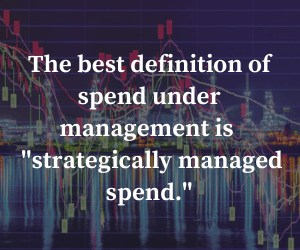Before getting into the topic, write down two things:
1) Your high-level definition of the term spend under management
2) What percentage of your company/organization’s spend would you estimate is under management?
Once you answer those questions, read on…
A common statistic most heads of procurement track and report on is their spend under management. If you ask them, most can tell you a specific percent of their company’s spend is under management. The problem is that every manager defines the term differently and often in a non-meaningful way. This leads to a heap of problems – all stemming from an ineffective procurement strategy. So how can they get back on track?
>>Get more resources, research and data on Spend Under Management<<
What Spend Under Management Is Not
I want to start with the big one first: It is NOT the percentage of spend that is touched by your procurement organization. Having a buyer push through a requisition operationally or having a purchase simply go through your procure-to-pay software without thinking about the purchase strategically is not spend under management, it is spend under procurement.
Even spend under contract is not a satisfactory measure, as many contracts get renewed with little consideration for alternatives, analyzing scope for potential changes, or even doing any negotiating other than potentially trying to limit a price increase.
Spend Under Management = Strategically Managed Spend
The best definition of spend under management to achieve the most effective metric is to equate it to "strategically managed spend." That involves taking the following measures:
- Understanding where your company spends money through regular spend analyses
- Employing category management techniques, such as consolidating purchases and performing regular evaluations of your most impactful suppliers
- Providing guided buying to end users, such as through catalogs or intuitive request processes
- Reviewing contracts with enough lead time before expiration to review scope and alternative solutions with the team responsible for the product
- Evaluating organizational performance with clearly defined metrics on target business outcomes, such as savings, cycle times or how your organization adds value to the company
- Working with your end-user teams to understand where you can bring value to their purchase decisions
Strategically managed spend can include items that are pushed through operationally when procurement identifies that there is not enough value gained from doing more with it. There is no value in strategically sourcing a $100 item purchased twice per year. Just ensure that similar $100 items aren’t being purchased a combined 200 times per year, which could result in real and operational savings by consolidating the purchases, keeping it to one SKU and negotiating a volume discount.
Using this new definition, re-run the exercise I asked you to do at the beginning of this article and ask yourself what percentage of your organization’s spend is strategically managed? That number is likely lower – and potentially even much lower – than what you gave initially.










